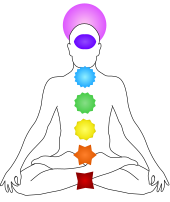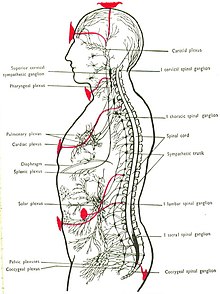The Seven Chakra System

One widely popular schema of seven chakras is as follows, from bottom to top: 1. Muladhara 2. Svadhisthana 3. Nabhi-Manipura 4. Anahata 5. Vishuddhi 6. Ajna 7. Sahasrara.[4] The colours are modern.[54]
The more common and most studied chakra system incorporates six major chakras along with a seventh center generally not regarded as a chakra. These points are arranged vertically along the axial channel (sushumna nadi in Hindu texts, Avadhuti in some Buddhist texts).[55] According to Gavin Flood, this system of six chakras plus the sahasrara "center" at the crown first appears in the Kubjikāmata-tantra, an 11th-century Kaula work.[56]
It was this chakra system that was translated in the early 20th century by Sir John Woodroffe (also called Arthur Avalon) in the text The Serpent Power. Avalon translated the Hindu text Ṣaṭ-Cakra-Nirūpaṇa meaning the examination (nirūpaṇa) of the seven (ṣaṭ) chakras (cakra).[57]
The Chakras are traditionally considered meditation aids. The yogi progresses from lower chakras to the highest chakra blossoming in the crown of the head, internalizing the journey of spiritual ascent.[58] In both the Hindu kundalini and Buddhist candali traditions, the chakras are pierced by a dormant energy residing near or in the lowest chakra. In Hindu texts she is known as Kundalini, while in Buddhist texts she is called Candali or Tummo (Tibetan: gtum mo, "fierce one").[59]
Below are the common new age description of these six chakras and the seventh point known as sahasrara. This new age version incorporates the Newtonian colors of the rainbow not found in any ancient Indian system.[54]
| Image of chakra | Name |
Sanskrit (Translation) |
Location | No. of petals |
Modern colour |
Seed syllable |
Description |
|---|---|---|---|---|---|---|---|
| Sahasrara | सहस्रार "Thousand-petaled" |
Crown | 1000 | Multi or violet | — | Highest spiritual centre, pure consciousness, containing neither object nor subject. When the feminine Kundalini Shakti rises to this point, it unites with the masculine Shiva, giving self-realization and samadhi.[4] In esoteric Buddhism, it is called Mahasukha, the petal lotus of "Great Bliss" corresponding to the fourth state of Four Noble Truths.[59] | |
| Ajna or Agya | आज्ञा "Command" |
Between eyebrows |
2 | Indigo | — | Guru chakra, or in New Age usage third-eye chakra, the subtle center of energy, where the tantra guru touches the seeker during the initiation ritual. He or she commands the awakened kundalini to pass through this centre.[4] | |
| Vishuddha | विशुद्ध "Purest" |
Throat | 16 | Blue |
Ham (space) |
16 petals covered with the sixteen Sanskrit vowels. Associated with the element of space (akasha). The residing deity is Panchavaktra shiva, with 5 heads and 4 arms, and the Shakti is Shakini.[4]
In esoteric Buddhism, it is called Sambhoga and is generally considered to be the petal lotus of "Enjoyment" corresponding to the third state of Four Noble Truths.[59] |
|
| Anahata | अनाहत "Unstruck" |
Heart | 12 | Green |
Yam (air) |
Within it is a yantra of two intersecting triangles, forming a hexagram, symbolising a union of the male and female, and the element of air (vayu). The presiding deity is Ishana Rudra Shiva, and the Shakti is Kakini.[4]
In esoteric Buddhism, this Chakra is called Dharma and is generally considered to be the petal lotus of "Essential nature" and corresponding to the second state of Four Noble Truths.[59] |
|
| Manipura | मणिपूर "Jewel city" |
Navel | 10 | Yellow |
Ram (fire) |
For the Nath yogi meditation system, this is described as the Madhyama-Shakti or the intermediate stage of self-discovery.[58] This chakra is represented as a downward pointing triangle representing fire in the middle of a lotus with ten petals. The presiding deity is Braddha Rudra, with Lakini as the Shakti.[4] | |
| Svadhishthana | स्वाधिष्ठान "Where the self is established" |
Root of sexual organs |
6 | Orange |
Vam (water) |
Svadhisthana is represented with a lotus within which is a crescent moon symbolizing the water element. The presiding deity is Brahma, with the Shakti being Rakini (or Chakini).[4]
In esoteric Buddhism, it is called Nirmana, the petal lotus of "Creation" and corresponding to the first state of Four Noble Truths.[59] |
|
| Muladhara | मूलाधार "Root" |
Base of spine |
4 | Red |
Lam (earth) |
Dormant Kundalini is often said to be resting here, wrapped three and a half, or seven or twelve times. Sometimes she is wrapped around the black Svayambhu linga, the lowest of three obstructions to her full rising (also known as knots or granthis).[60] It is symbolised as a four-petaled lotus with a yellow square at its center representing the element of earth.[4]
The seed syllable is Lam for the earth element. All sounds, words and mantras in their dormant form rest in the muladhara chakra, where Ganesha resides,[61] while the Shakti is Dakini.[62] The associated animal is the elephant.[63] |
Try AUDIBLE PLUS - Free 30 day trial - AUDIOBOOKS & PODCASTS for all YOUR INTERESTS!
Western chakra system
Modern history
Chakra positions in supposed relation to nervous plexuses, from Charles W. Leadbeater's 1927 book The Chakras Kurt Leland, for the Theosophical Society in America, concluded that the western chakra system was produced by an "unintentional collaboration" of many groups of people: esotericists and clairvoyants, often theosophical; Indologists; the scholar of myth, Joseph Campbell; the founders of the Esalen Institute and the psychological tradition of Carl Jung; the colour system of Charles W. Leadbeater's 1927 book The Chakras,[64] treated as traditional lore by some modern Indian yogis; and energy healers such as Barbara Brennan.[54][65] Leland states that far from being traditional, the two main elements of the modern system, the rainbow colours and the list of qualities, first appeared together only in 1977.[54]
The concept of a set of seven chakras came to the West in the 1880s; at that time each chakra was associated with a nerve plexus.[54] In 1918, Sir John Woodroffe, alias Arthur Avalon, translated two Indian texts, the Ṣaṭ-Cakra-Nirūpaṇa and the Pādukā-Pañcaka, and in his book The Serpent Power drew Western attention to the seven chakra theory.[66]
In the 1920s, each of the seven chakras was associated with an endocrine gland,[54] a tradition that has persisted.[67][68][69] More recently, the lower six chakras have been linked to both nerve plexuses and glands.[70] The seven rainbow colours were added by Leadbeater in 1927; a variant system in the 1930s proposed six colours plus white.[54] Leadbeater's theory was influenced by Johann Georg Gichtel's 1696 book Theosophia Practica, which mentioned inner "force centres".[71]
Psychological and other attributes such as layers of the aura, developmental stages, associated diseases, Aristotelian elements, emotions, and states of consciousness were added still later.[54] A wide range of supposed correspondences such as with alchemical metals, astrological signs and planets, foods, herbs, gemstones, homeopathic remedies, Kabbalistic spheres, musical notes, totem animals, and Tarot cards have also been proposed.[54]
New Age
In Anatomy of the Spirit (1996), Caroline Myss described the function of chakras as follows: "Every thought and experience you've ever had in your life gets filtered through these chakra databases. Each event is recorded into your cells...".[72] The chakras are described as being aligned in an ascending column from the base of the spine to the top of the head. New Age practices often associate each chakra with a certain colour. In various traditions, chakras are associated with multiple physiological functions, an aspect of consciousness, a classical element, and other distinguishing characteristics; these do not correspond to those used in ancient Indian systems. The chakras are visualised as lotuses or flowers with a different number of petals in every chakra.[54]
The chakras are thought to vitalise the physical body and to be associated with interactions of a physical, emotional and mental nature. They are considered loci of life energy or prana (which New Age belief equates with shakti, qi in Chinese, ki in Japanese, koach-ha-guf[73] in Hebrew, bios in Greek, and aether in both Greek and English), which is thought to flow among them along pathways called nadi. The function of the chakras is to spin and draw in this energy to keep the spiritual, mental, emotional and physical health of the body in balance.[74]
Rudolf Steiner considered the chakra system to be dynamic and evolving. He suggested that this system has become different for modern people than it was in ancient times and that it will, in turn, be radically different in future times.[75][76][77] Steiner described a sequence of development that begins with the upper chakras and moves down, rather than moving in the opposite direction. He gave suggestions on how to develop the chakras through disciplining thoughts, feelings, and will.[78] According to Florin Lowndes, a "spiritual student" can further develop and deepen or elevate thinking consciousness when taking the step from the "ancient path" of schooling to the "new path" represented by Steiner's The Philosophy of Freedom.[79]
*content credit Wikipedia
Try AUDIBLE PLUS - Free 30 day trial - AUDIOBOOKS & PODCASTS for all YOUR INTERESTS!
#ChakraSystem, #EnergyHealing, #SpiritualWellness, #ChakraBalance, #MindBodySpirit, #HolisticHealth, #Yoga, #Meditation, #InnerPeace, #SelfCare








